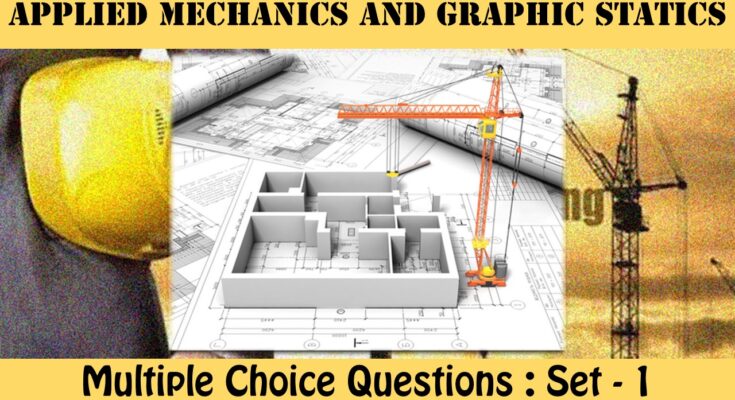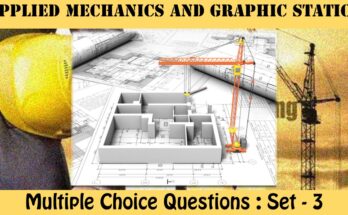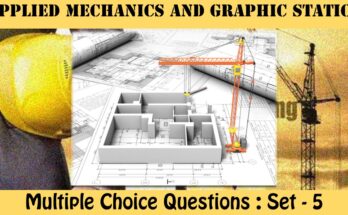MCQ Questions Civil Engineering Applied Mechanics and Graphic Statics
The interviewer is almost as nervous as the candidate in most interviews. You might wonder if you look confident enough, if you will hire the right person, or if you are asking the right engineering interview questions. The last question is arguably the most crucial part to worry about when you’re interviewing candidates. Other topics on Civil Engineering Multiple Choice Questions can be accessed
MCQ Questions Civil Engineering Applied Mechanics and Graphic Statics - Set - 1
Question 1:
In which of the following trusses, the method of substitution is required for determining the forces in all the members of the truss by graphic statics ?
a) howe truss
b) king post truss
c) fink truss
d) warren truss
Correct Answer – (C)
Question 2 :
If the given forces P,, P2, P3 and P4 are such that the force polygon does not close, then the system will
a) be in equilibrium
b) always reduce to a resultant force
c) always reduce to a couple
d) both (a) and (c)
Correct Answer – (B)
Question 3 :
The resultant of two forces P and Q is R. If Q is doubled, the new resultant is perpendicular to P. Then,
a) P = R
b) Q = R
c) P = Q
d) None of the above is correct
Correct Answer – (B)
Question 4 :
The angles between two forces to make their resultant a minimum and a maximum respectively are
a) 0° and 90°
b) 180° and 90°
c) 90° and 180°
d) 180° and 0°
Correct Answer – (D)
Question 5 :
If the resultant of two forces has the same magnitude as either of the force, then the angle between the two forces is
a) 30°
b) 45°
c) 60°
d) 120°
Correct Answer – (D)
MCQ Questions Civil Engineering Applied Mechanics and Graphic Statics
Question 6:
The condition of equilibrium for any system of forces in a plane is
a) that polygon of forces must close
b) that resultant couple must be zero
c) both (a) and (b)
d) none of the above
Correct Answer – (C)
Question 7:
A funicular polygon cannot be made to pass through
a) one specified point
b) two specified points
c) three specified points
d) more than three specified points
Correct Answer – (D)
Question 8:
When two forces, each equal to P, act at 90° to each other, then the resultant will be
a) P
b) PV2
c) P/V2
d) 2P
Correct Answer – (B)
Question 9:
A rod AB carries three loads of 30 N, 70 N and 100 N at distances of 20 mm, 90 mm and 150 mm respectively from A. Neglecting the weight of the rod, the point at which the rod will balance is
a) 109.5 mm from A
b) 119.5 mm from A
c) 125.5 mm from A
d) 132.5 mm from A
Correct Answer – (A)
Question 10:
A force P of 50 N and another force Q of unknown magnitude act at 90° to each other. They are balanced by a force of 130 N. The magnitude of Q is
a) 60 N
b) 80 N
c) 100 N
d) 120 N
Correct Answer – (D)
- NCERT Solutions Class 12 Mathematics RD Sharma Sets : Exercise 1.1
- NCERT Solutions Class 12 Mathematics RD Sharma Sets : Exercise 1.2
- NCERT Solutions Class 12 Mathematics RD Sharma Sets : Exercise 1.3
- NCERT Solutions Class 12 Mathematics RD Sharma Sets : Exercise 1.4
- NCERT Solutions Class 12 Mathematics RD Sharma Trigonometric Functions : Exercise – 5.1
- NCERT Solutions Class 12 Mathematics RD Sharma Trigonometric Functions : Exercise – 5.2
- NCERT Solutions Class 12 Mathematics RD Sharma Trigonometric Functions : Exercise – 5.3
- NCERT Solutions Class 12 Mathematics RD Sharma Quadratic Equations : Exercise – 14.1
- NCERT Solutions Class 12 Mathematics RD Sharma Quadratic Equations : Exercise – 14.2
- NCERT Solutions Class 12 Mathematics RD Sharma Linear Inequations : Exercise – 15.1
- NCERT Solutions Class 12 Mathematics RD Sharma Linear Inequations : Exercise – 15.2
- NCERT Solutions Class 12 Mathematics RD Sharma Linear Inequations : Exercise – 15.3
- NCERT Solutions Class 12 Mathematics RD Sharma Linear Inequations : Exercise – 15.4
- NCERT Solutions Class 12 Mathematics RD Sharma Linear Inequations : Exercise – 15.5
- NCERT Solutions Class 12 Mathematics RD Sharma Linear Inequations : Exercise – 15.6
Multiple Choice Questions for Competitive Exams
- Multiple Choice Questions Class 12 Chemistry The Solid State
Set -1 Set -2 Set -3 Set -4 Set -5 - MCQ Questions Class 12 Solutions With Answers
Set -1 Set -2 Set -3 Set -4 Set -5 - MCQ Questions Class 12 Electrochemistry With Answers
Set -1 Set -2 Set -3 Set -4 Set -5 - MCQ Questions Class 12 Chemical Kinetics With Answers
Set -1 Set -2 Set -3 Set -4 Set -5 - MCQ Questions Class 12 Surface Chemistry With Answers
Set -1 Set -2 Set -3 Set -4 Set -5 - MCQ Questions Class 12 General Principles and Processes of Isolation of Elements With Answers
Set -1 Set -2 Set -3 Set -4 Set -5




